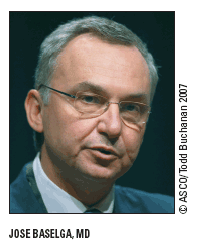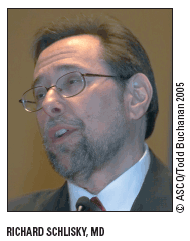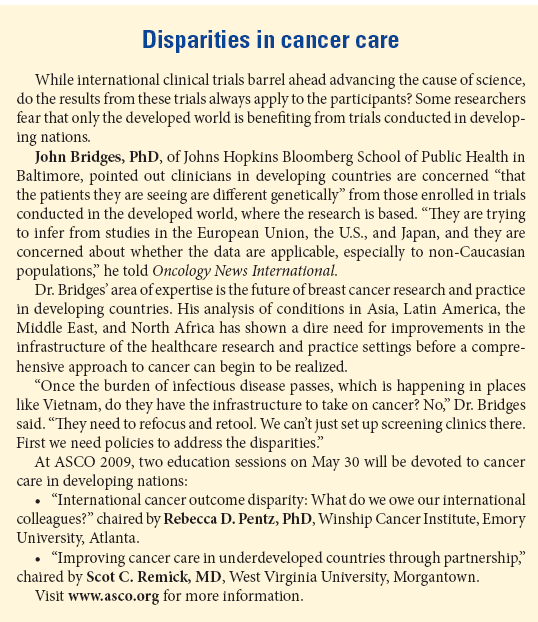Clinical trials flourish in international setting
A call center in India takes a customer service inquiry from Idaho; an Australian doctor reads an emergency x-ray for a U.S. patient; a professor in Moscow delivers a lecture via satellite to UK-based students-these examples of “going global” no longer seem so novel. Cancer clinical trials are also crossing international datelines. Between 2005 and 2006, international clinical trials initiated in the Asia-Pacific region increased by 50%, while major research initiatives-once the stronghold of U.S. institutions-are now run by EU-based investigators.
ABSTRACT: Europe is firmly established as a trial venue, while the Asia-Pacific region is gaining ground thanks in part to efficient trial systems and rapid recruitment.
A call center in India takes a customer service inquiry from Idaho; an Australian doctor reads an emergency x-ray for a U.S. patient; a professor in Moscow delivers a lecture via satellite to UK-based students-these examples of “going global” no longer seem so novel. Cancer clinical trials are also crossing international datelines. Between 2005 and 2006, international clinical trials initiated in the Asia-Pacific region increased by 50%, while major research initiatives-once the stronghold of U.S. institutions-are now run by EU-based investigators.
Globalization isn’t the only reason that trials have shifted to other countries. Increasingly, U.S. cancer trials are fraught with problems, including a bureaucracy that eats up research time and a reluctant patient pool (see Table on page 12).
At ASCO 2009 in Orlando, ASCO and ESMO will hold a joint symposium, “Global Clinical Trials-Challenges and Solutions,” to identify global issues in clinical trial accrual, data sharing, and trial design. The June 1 special session will be cochaired by ASCO president Richard Schilsky, MD, of the University of Chicago and ESMO president Jose Baselga, MD, of Vall d’Hebron University in Barcelona.
“We felt this (symposium) was really becoming necessary because of the increasing number of global trial protocols,” Dr. Baselga told Oncology News International.

Dr. Baselga, along with other experts, talked with Oncology News International about the rationale behind international clinical trials and why, in many instances, our colleagues overseas do it better.
Making trial enrollment the rule
The ALTTO (Adjuvant Lapatinib and/or Trastuzumab Treatment Optimisation) study will randomize 8,000 patients from 49 countries and 1,300 sites and look at the efficacy of combining two anti-HER2 agents. Due to extremely high interest in the research question, the study is accruing rapidly, Dr. Baselga reported.
ALTTO is organized by the European-based Breast International Group (BIG), which consists of a network of 44 collaborative groups, research partnerships, and trial units from Europe, Canada, Latin America, and the Asia-Pacific region. BIG recently forged ties with NCI and the National Surgical Adjuvant Breast and Bowel Project.
While the North Central Cancer Treatment Group in the U.S. is co-coordinating ALTTO, it will contribute only a minor proportion of patients: just one for every 40 recruited from other regions, according to Dr. Baselga. The imbalance in the ALTTO patient enrollment reflects a major difference between U.S. and European trials: Both European patients and physicians are more open to trials.
“Outside of the United States, patients often have better access to therapies within clinical trials. In fact, sometimes they cannot get the best treatment without it,” Dr. Baselga said. “In my department, 20% of our breast cancer patients are enrolled in trials. We assess every patient in a committee before we determine treatment, and we see if she is eligible for a trial. It is expected.”
Michael Gnant, MD, of the Austrian Breast and Colon Study Group (ABCSG) echoed that statement, explaining that the majority of patients in his country are enrolled in trials.
“The high enrollment in our trials is the result of a group of scientists and physicians working together for more than 20 years,” Dr. Gnant said. “In Austria, many are convinced that clinical trials ensure treatment quality for patients. We have numerous communication activities aimed at doctors, patients, advocacy groups, and the media. Scientifically, we feel this is the best chance for a small country to be successful on a global stage.”

The ABCSG tries to make trial enrollment simple for patients and physicians. “We have a web-based randomization and documentation system, and we have monitors and data managers who try to take the bureaucratic burden away from the individual oncologist,” he said.
Quicker turnaround
An investigation done at the Center for Management Research at Nashville’s Vanderbilt University found that it required nearly 2.5 years to design and open a clinical trial in the United States (J Clin Oncol 24:4553-4557, 2006).
That’s hardly the case in other countries, according to David Kerr, MD, president-elect of ESMO and Rhodes Professor of Clinical Pharmacology and Cancer Therapeutics at Oxford University. Dr. Kerr is heavily involved in global trials conducted in Spain, Austria, France, Australia, and several Eastern European countries.
“With our international collaborations there are always complexities around the start-up, but once they are up and running, they go well, . . . usually, the time from developing the protocol to the first enrollment is about one year,” he said.
The future lies east
The pharmaceutical industry has long looked to Europe as the initial testing ground for new compounds, but new venues for early-phase studies are gaining momentum.
A 2008 report in the Good Clinical Practice Journal (www.pjbpubs.com) found that companies are increasingly moving their oncology trial sites to countries in Asia. “Overall, we are seeing a 50% increase in the number of oncology trials started in Asia in 2007 vs 2004. South Korea, in particular, saw a 2.5-fold increase. In Western Europe, formerly a site of growth, the trend is reversed, with a decrease in sites in all major European countries except Spain,” noted Alice Ng Fink, the report’s author.
“We were also surprised to see a relatively stable count in Eastern Europe and a 30% decrease in Latin America, as many in the industry had speculated that trials were moving into these locations over the past several years,” Ms. Fink added.
Global clinical trials initiated in the Asia-Pacific region increased 50% between 2005 and 2006, led by Taiwan, Korea, and India. India’s participation in global trials nearly quintupled between 2001 and 2005, thanks to investment by large international and domestic pharmaceutical companies, Western biotechnology, and even the NIH. India established itself as a trial site when its business and regulatory climates underwent dramatic changes that brought it in line with developed nations, according to the clinical trials site Centerwatch (“The Emerging Markets of Clinical Research,” www.centerwatch.com). Japan has also experienced a dramatic increase in global clinical trials, largely because of new government initiatives that make for a more conducive environment, according to the report.

Finally, Russia is a site of growing interest; FDA applications for products based on research conducted in Russia tripled between 2001 and 2006. The FDA and the European Medicines Agency (EMEA) have begun approving drugs with clinical trial data from Russian sites, which is considered a mark of quality, the report stated.
What makes these sites so appealing? Factors include a large number of treatment-nave patients, faster patient enrollment times, and emerging economic power. Extending clinical trials to Asian populations also enlarges the knowledge base about cancer and the relative efficacy of treatments. For example, the IPASS trial, conducted in nine Asian countries, confirmed that Asian nonsmokers with adenocarcinoma of the lung had a higher response to gefitinib (Iressa) than other groups. And Indian breast cancer patients appear to have more triple-negative and grade 3 tumors, more aggressive mucinous carcinomas, and possibly a higher incidence of BRCA1-associated tumors, according to information from BIG.
“Studies conducted in India are trying to elucidate whether the biology of breast cancer is different from the one seen in studies on Western populations,” said Tushar Vora, MD, of Tata Memorial Hospital in Mumbai (BIG newsletter 10:17, 2008).
Regulations and return on investment
International trials are far from being a walk in the park. Obstacles that can slow down even the most streamlined international trial include physically transporting drugs into a country and navigating strict application deadlines. South Africa, for example, has six submission dates per year on which trial sponsors can submit their plans.

Obtaining regulatory approval from several different entities in multiple countries can be a time-consuming process. In turn, the trial must be completed at a level of compliance that’s acceptable to the FDA. Dr. Gnant sees such globalization as both a challenge and an opportunity for “responsible research leaders all over the world.”
Lack of planning fells many international clinical studies, which can be delayed because of a study design or protocol that doesn’t take local practice into account, poor translation of documents into the native language, or lack of knowledge of local regulations.
When organized and launched correctly, international trials offer benefits that translates well into any language: cost savings. A trial that recruits enough patients and closes on time can reduce investigator fees or monitoring costs. And the sooner a trial reaches completion, the faster the drug can be taken to market.